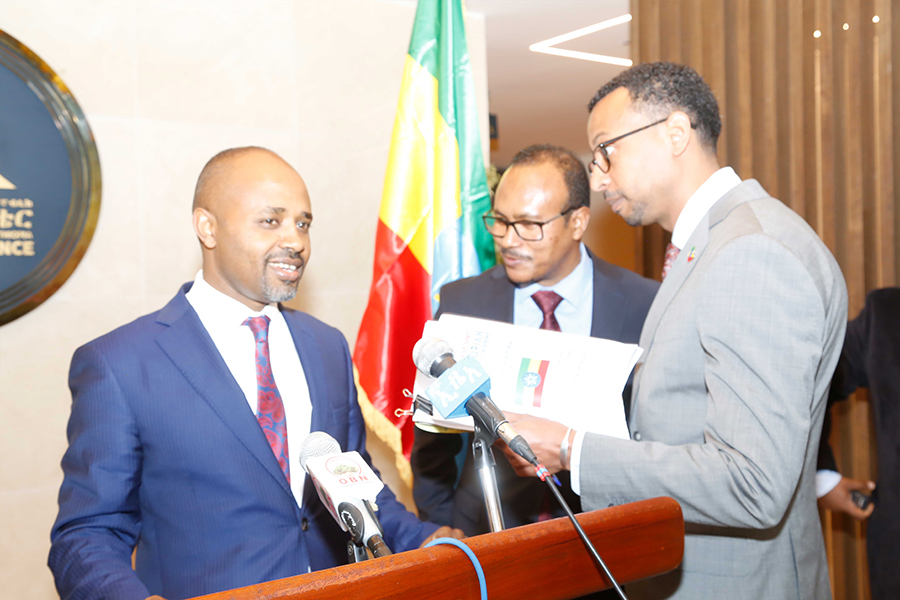
Commentaries | Jul 13,2019
Ethiopia has asked for 1.6 billion dollars of emergency funding from the Development Assistance Group (DAG), a consortium of 30 bilateral nations and multilateral agencies supporting the country, to aid people that will be impacted in the event of a widespread Novel Coronavirus (COVID-19) outbreak.
The Ministry of Finance filed the proposal to DAG early last week, stating that the funds will be used for three months to execute the emergency response plan the government drafted with the United Nations (UN). If the virus breaks out significantly in Ethiopia, the plan indicates that an estimated 10 million people will require emergency assistance.
The largest fund, accounting for 635 million dollars, will be used to serve food to 15 million people. For the provision of health services for 39 million people, the country requires 430 million dollars. Ethiopia will also need 282 million dollars to provide shelter and non-food items for 2.5 million people, according to the emergency response plan.
The 60-page document, dubbed the COVID-19 Multi-Sectoral Preparedness & Response Plan, consists of a far-reaching response plan on agriculture, education, shelter, food, health, nutrition, water, sanitation and care for refugees. It also includes cross-cutting coordination and management strategies for three possible stages of increasing intensity.
“The pandemic couldn't have come at a worse time - just as the country is undergoing major macroeconomic reform,” said Eyob Tekalign (PhD), state minister for Finance, which has allocated five billion Birr for the prevention of the pandemic and 19 billion Br for the worst-case scenario.
The World Bank has estimated that, at a minimum, the economy will slow down significantly in the last quarter of the current fiscal year and remain slower than the pre-COVID-19 scenario in the next fiscal year with an expected recovery to commence in the second quarter of 2021.
With many uncertainties in global markets, Foreign Direct Investment (FDI) has fallen by a third, potentially leading to an external financing gap of over two billion dollars. From March to June, exports are expected to fall by 30pc this year compared to last year. Remittances, which make up six percent of the country's GDP, are expected to drop by at least 40pc between February and June or 75pc in the worst-case scenario.
At a preliminary status, the Job Creation Commission projects that in the next three months, 1.4 million jobs will be under threat. Urban, self-employed residents in the service sector are expected to lose 265 million dollars in income.
As of the end of the last week, 69 cases have been confirmed in the country, with three fatalities and 10 recoveries. In the coming three months, the government expects 102,000 confirmed cases, according to the response plan.
With the projected need, Ethiopia should have 300 isolation centres with 200 beds each, 34 treatment centres with 400 beds each and 100 quarantine centres with 500 beds each. It should also expand the testing capacity to 19 sites throughout the country, including both referral and teaching hospitals. The procurement of 300 ambulances with 300 sprayers and 600 nurses working in the ambulances is also required.
The agriculture sector, which represents the highest share of the country's GDP, is already under threat from the desert locust invasion affecting the crop production in the Belg area of the country, according to the response plan.
Approximately, 18 million hectares or 84pc of cropland in Ethiopia is now affected by locusts, according to a report by Gro Intelligence, a company that provides data on agriculture. Delays in the availability of agricultural inputs, fertiliser, pesticide and seeds will highly impact crop production and cultivation for the coming seasonal harvests, according to their data.
The response plan allocated 24 million dollars to rescue the agriculture sector through more than 20 execution strategies.
The agricultural sector impact has a direct implication on the food security of the country. Currently, there are about 5.9 million people being cared for under the Humanitarian Response Plan 2020, including vulnerable groups such as internally displaced people, while the national food poverty index indicates that 24 million people are vulnerable to food insecurity.
The spread of the virus could mean that five million more people will need food assistance, increasing the total number of people that require emergency assistance to 11 million. The present plan includes feeding people in quarantine, isolation centres and deportees with nutritious food baskets. The food baskets will have cereals, pulses and vegetable oil, while additional food items, such as biscuits, will be provided to the most vulnerable households. “We have already mapped out every corner of the capital city in case things get dire in order to reach every community living in the city,” said Eyob.
After the Council of Ministers decided to close schools and learning institutions in March, a total of 26 million students in pre-primary, primary and secondary levels of education have been affected. The National Exams for grade eight and 12 have been postponed.
The plan aims to work on the quick implementation of digital technology and innovative initiatives to support the practice of continuing school virtually. It also estimated that 70pc and 40pc of the community have access to radio and television, respectively, which can be used for continuing school at home.
A macroeconomist who wanted to remain anonymous commented that the crisis will not be solved by the amount that has been requested for the emergency fund.
"It may come to the point that the government needs more than this in the worst-case scenario," said the macroeconomist. "The absence of remittances and exports is going to deteriorate the macroeconomic imbalance."
The next most scary thing is how can the country get back on its feet after this, according to the expert, who adds that the government should start working on a recovery plan for after the crisis.
And this is the perfect time to capitalise on agriculture production, in parallel, by containing the desert locust invasion and focusing on how to make crop production more effective by ensuring the most strict and firm safety precautions and food security, according to the expert.
PUBLISHED ON
Apr 12,2020 [ VOL
21 , NO
1041]

Viewpoints | Aug 17,2019

Fortune News | Nov 29,2020

Radar | Jul 06,2025

Obituary | Jan 25,2025

Fortune News | Apr 26,2019

Dec 22 , 2024 . By TIZITA SHEWAFERAW
Charged with transforming colossal state-owned enterprises into modern and competitiv...

Aug 18 , 2024 . By AKSAH ITALO
Although predictable Yonas Zerihun's job in the ride-hailing service is not immune to...

Jul 28 , 2024 . By TIZITA SHEWAFERAW
Unhabitual, perhaps too many, Samuel Gebreyohannes, 38, used to occasionally enjoy a couple of beers at breakfast. However, he recently swit...

Jul 13 , 2024 . By AKSAH ITALO
Investors who rely on tractors, trucks, and field vehicles for commuting, transporting commodities, and f...

Oct 25 , 2025
The regulatory machinery is on overdrive. In only two years, no fewer than 35 new pro...

Oct 18 , 2025
The political establishment, notably the ruling party and its top brass, has become p...

Oct 11 , 2025
Ladislas Farago, a roving Associated Press (AP) correspondent, arrived in Ethiopia in...

Oct 4 , 2025
Eyob Tekalegn (PhD) had been in the Governor's chair for only weeks when, on Septembe...